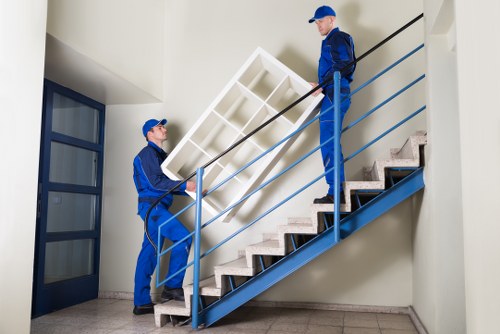Mastering Your Move: The Essential Guide to Moving Trucks and Removal Vans

Moving to a new home or office can be both an exciting and daunting experience. One of the most critical decisions you'll make during this process is choosing the right moving truck or removal van. Understanding the differences, benefits, and best practices can make your move smoother and more efficient.
In this comprehensive guide, we'll delve into everything you need to know about moving trucks and removal vans. From selecting the right vehicle size to packing strategies, we've got you covered.
Whether you're a first-time mover or a seasoned relocator, this article will provide valuable insights to ensure your belongings reach their destination safely and on time.

Understanding the Basics
Before selecting a moving truck or removal van, it's essential to understand the basics of each option. Both vehicles serve the primary purpose of transporting your belongings, but they come with different features and capabilities.
Moving Trucks are typically larger and offer more space, making them ideal for long-distance moves or transporting a significant amount of furniture and boxes. They come in various sizes, from small 10-foot trucks to large 26-foot models, accommodating different moving needs.
On the other hand, Removal Vans are usually more compact and easier to maneuver, especially in urban areas with narrow streets and tight parking spaces. They are perfect for smaller moves, apartment relocations, or businesses moving office equipment.

Choosing the Right Vehicle Size
One of the most critical aspects of hiring a moving truck or removal van is selecting the appropriate size for your move. An oversized vehicle can lead to unnecessary costs, while an undersized one may result in multiple trips or damaged items.
Assessing Your Needs
Start by evaluating the volume and weight of your belongings. Create an inventory list and estimate the space required for your items. Consider the number of rooms, large furniture pieces, and any special items like pianos or appliances.
Standard Sizes Explained
Here's a breakdown of common moving truck sizes and their typical uses:
- 10-Foot Truck: Suitable for studio or one-bedroom apartments with minimal furniture.
- 15-Foot Truck: Ideal for one to two-bedroom homes, offering extra space for larger items.
- 20-Foot Truck: Perfect for three-bedroom houses with more substantial furniture and appliances.
- 26-Foot Truck: Best for large homes, multiple vehicles, or extensive commercial moves.

Cost Considerations
Budget is a significant factor when choosing between a moving truck and a removal van. Understanding the cost structure can help you make an informed decision.
Moving Truck Costs typically include rental fees based on the truck's size and the duration of the rental. Additional costs may arise from mileage, fuel consumption, insurance, and any required equipment like dollies or straps.
In contrast, Removal Van Costs are generally lower due to the vehicle's smaller size and fuel efficiency. However, it's essential to factor in potential extra trips if you're moving a large volume of items.
Saving Tips
- Book Early: Reserving your vehicle in advance can secure better rates and availability.
- Compare Prices: Get quotes from multiple providers to find the best deal.
- Pack Efficiently: Maximize space by using proper packing techniques to reduce the number of trips needed.

Insurance and Protection
Protecting your belongings during the move is paramount. Both moving trucks and removal vans offer various insurance options to safeguard against potential damages or losses.
Types of Coverage
When renting a moving truck or removal van, you can typically choose from the following insurance options:
- Basic Coverage: Usually included in the rental price, it offers minimal protection against damages.
- Full Coverage: Provides comprehensive protection for both the vehicle and your belongings.
- Third-Party Insurance: Covers liabilities in case of accidents involving other parties.
Choosing the Right Insurance
Assess the value of your belongings and your comfort level with risk to determine the appropriate level of coverage. Investing in higher coverage can provide peace of mind, especially for long-distance or high-value moves.
Contact us today to discuss the best insurance options for your upcoming move.

Packing and Loading Tips
Efficient packing and loading are crucial for a successful move. Properly organizing your belongings can prevent damage and make unloading easier.
Effective Packing Strategies
Use sturdy boxes and packing materials to secure your items. Label each box with its contents and the room it belongs to, facilitating easier unpacking at your new location.
Maximizing Space
Disassemble large furniture pieces when possible to save space. Utilize every nook and cranny of the truck or van by stacking boxes and furniture strategically.
Safety First
Ensure that all items are securely tied down to prevent shifting during transit. Use straps, ropes, or bungee cords for added stability.

Driving and Navigation Tips
Driving a moving truck or removal van requires attention and preparation. Here are some tips to help you navigate safely and efficiently:
Plan Your Route
Before setting out, map your route to avoid heavy traffic, construction zones, and narrow streets. Familiarize yourself with the area's parking regulations and loading zones.
Driving Techniques
Maintain a steady speed and allow for increased stopping distances due to the vehicle's size. Use your mirrors frequently and be mindful of blind spots.
Rest and Breaks
Take regular breaks to stay alert and avoid fatigue, especially during long-distance moves.

Unloading and Settling In
Once you've arrived at your new location, unloading and settling in efficiently can save time and reduce stress.
Organized Unloading
Start by unloading the essentials first, such as kitchen items and bedding, to set up your new home quickly. Follow the labeling system you used during packing to place boxes in their designated rooms.
Inspecting for Damage
As you unload, inspect your belongings for any damage that may have occurred during transit. Report any issues to your moving company immediately.
Setting Up Your Space
Arrange furniture and set up your new space according to your plan. Take your time to ensure everything is placed where you want it.

Environmental Considerations
Moving can have an environmental impact. Here are some ways to make your move more eco-friendly.
Choosing Fuel-Efficient Vehicles
Selecting a fuel-efficient moving truck or removal van can reduce your carbon footprint. Hybrid or smaller vehicles consume less fuel and are better for the environment.
Reducing Waste
Reuse or recycle packing materials whenever possible. Donate or sell items you no longer need instead of discarding them.
Eco-Friendly Packing Materials
Opt for sustainable packing materials, such as biodegradable bubble wrap or recycled boxes, to minimize environmental impact.

Hiring Professional Movers vs. DIY
Deciding whether to hire professional movers or handle the move yourself is a significant consideration.
Benefits of Professional Movers
Professional moving companies offer expertise, equipment, and manpower to handle all aspects of your move efficiently. They can save you time and reduce the physical strain associated with moving.
Pros of DIY Moves
Handling the move yourself can be more cost-effective and give you greater control over the process. It's a viable option for smaller moves or those on a tight budget.
Making the Choice
Consider factors such as the distance of the move, the volume of belongings, budget, and personal preferences when deciding between professional movers and a DIY approach.
Book your service now to experience a hassle-free moving process with our expert team.

Common Moving Challenges and Solutions
Moving comes with its set of challenges, but with proper planning and strategies, you can overcome them effectively.
Time Management
One of the most significant challenges is managing time efficiently. Create a moving timeline, prioritize tasks, and set realistic deadlines to stay on track.
Handling Delicate Items
Protect fragile items by using appropriate packing materials and labeling boxes as 'Fragile.' Consider climate-controlled moving trucks for sensitive items like electronics or antiques.
Unexpected Issues
Be prepared for unforeseen circumstances such as bad weather or vehicle breakdowns. Having a contingency plan can help you navigate these challenges smoothly.

Post-Move Checklist
After the move, there's still work to be done to ensure everything is in order.
Inspecting the New Location
Check the new home or office for any damages or issues that need immediate attention. Ensure utilities are functioning correctly and that all repairs, if any, are underway.
Unpacking and Organizing
Start unpacking systematically, beginning with essential areas like the kitchen and bedrooms. Organize items to create a comfortable and functional living or working space.
Updating Address Information
Don't forget to update your address with relevant institutions, such as banks, postal services, and subscriptions, to ensure a smooth transition.
Contact us today to assist you with every step of your move, ensuring a seamless relocation experience.